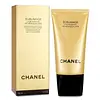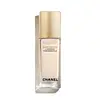What's inside
What's inside
 Key Ingredients
Key Ingredients

 Benefits
Benefits

 Concerns
Concerns

 Ingredients Side-by-side
Ingredients Side-by-side

Caprylic/Capric Triglyceride
MaskingSimmondsia Chinensis Seed Oil
EmollientGlycerin
HumectantWater
Skin ConditioningSucrose Laurate
EmollientSucrose Palmitate
EmollientVanilla Planifolia Fruit Water
Skin ConditioningHarungana Madagascariensis Extract
Skin ConditioningCamellia Oleifera Seed Oil
Skin ConditioningPhenoxyethanol
PreservativeParfum
MaskingDisodium Phosphate
BufferingPropylene Glycol
HumectantChlorphenesin
AntimicrobialCitric Acid
BufferingPentaerythrityl Tetra-Di-T-Butyl Hydroxyhydrocinnamate
AntioxidantTocopherol
AntioxidantCaprylic/Capric Triglyceride, Simmondsia Chinensis Seed Oil, Glycerin, Water, Sucrose Laurate, Sucrose Palmitate, Vanilla Planifolia Fruit Water, Harungana Madagascariensis Extract, Camellia Oleifera Seed Oil, Phenoxyethanol, Parfum, Disodium Phosphate, Propylene Glycol, Chlorphenesin, Citric Acid, Pentaerythrityl Tetra-Di-T-Butyl Hydroxyhydrocinnamate, Tocopherol
Water
Skin ConditioningGlycerin
HumectantAlcohol
AntimicrobialSilica
AbrasivePropanediol
SolventButyrospermum Parkii Butter
Skin ConditioningPentylene Glycol
Skin ConditioningSqualane
EmollientVanilla Planifolia Fruit Water
Skin ConditioningSecale Cereale Seed Extract
AbrasiveFaex
Skin ConditioningSolidago Virgaurea Extract
Skin ConditioningPhenoxyethanol
PreservativePolyacrylate Crosspolymer-6
Emulsion StabilisingAmmonium Acryloyldimethyltaurate/Vp Copolymer
Steareth-21
CleansingPropylene Glycol
HumectantEthylhexyl Methoxycinnamate
UV AbsorberParfum
MaskingSodium Hyaluronate
HumectantPolyquaternium-51
Skin ConditioningButyl Methoxydibenzoylmethane
UV AbsorberEthylhexyl Salicylate
UV AbsorberAdenosine
Skin ConditioningLactic Acid
BufferingPhytic Acid
Sodium Citrate
BufferingT-Butyl Alcohol
PerfumingEthylhexylglycerin
Skin ConditioningPalmitoyl Tetrapeptide-7
Skin ConditioningSodium Benzoate
MaskingCitric Acid
BufferingCI 14700
Cosmetic ColorantCI 15985
Cosmetic ColorantCI 19140
Cosmetic ColorantWater, Glycerin, Alcohol, Silica, Propanediol, Butyrospermum Parkii Butter, Pentylene Glycol, Squalane, Vanilla Planifolia Fruit Water, Secale Cereale Seed Extract, Faex, Solidago Virgaurea Extract, Phenoxyethanol, Polyacrylate Crosspolymer-6, Ammonium Acryloyldimethyltaurate/Vp Copolymer, Steareth-21, Propylene Glycol, Ethylhexyl Methoxycinnamate, Parfum, Sodium Hyaluronate, Polyquaternium-51, Butyl Methoxydibenzoylmethane, Ethylhexyl Salicylate, Adenosine, Lactic Acid, Phytic Acid, Sodium Citrate, T-Butyl Alcohol, Ethylhexylglycerin, Palmitoyl Tetrapeptide-7, Sodium Benzoate, Citric Acid, CI 14700, CI 15985, CI 19140
Ingredients Explained
These ingredients are found in both products.
Ingredients higher up in an ingredient list are typically present in a larger amount.
Citric Acid is an alpha hydroxy acid (AHA) naturally found in citrus fruits like oranges, lemons, and limes.
Like other AHAs, citric acid can exfoliate skin by breaking down the bonds that hold dead skin cells together. This helps reveal smoother and brighter skin underneath.
However, this exfoliating effect only happens at high concentrations (20%) which can be hard to find in cosmetic products.
Due to this, citric acid is usually included in small amounts as a pH adjuster. This helps keep products slightly more acidic and compatible with skin's natural pH.
In skincare formulas, citric acid can:
While it can provide some skin benefits, research shows lactic acid and glycolic acid are generally more effective and less irritating exfoliants.
Most citric acid used in skincare today is made by fermenting sugars (usually from molasses). This synthetic version is identical to the natural citrus form but easier to stabilize and use in formulations.
Read more about some other popular AHA's here:
Learn more about Citric AcidGlycerin is already naturally found in your skin. It helps moisturize and protect your skin.
A study from 2016 found glycerin to be more effective as a humectant than AHAs and hyaluronic acid.
As a humectant, it helps the skin stay hydrated by pulling moisture to your skin. The low molecular weight of glycerin allows it to pull moisture into the deeper layers of your skin.
Hydrated skin improves your skin barrier; Your skin barrier helps protect against irritants and bacteria.
Glycerin has also been found to have antimicrobial and antiviral properties. Due to these properties, glycerin is often used in wound and burn treatments.
In cosmetics, glycerin is usually derived from plants such as soybean or palm. However, it can also be sourced from animals, such as tallow or animal fat.
This ingredient is organic, colorless, odorless, and non-toxic.
Glycerin is the name for this ingredient in American English. British English uses Glycerol/Glycerine.
Learn more about GlycerinParfum is a catch-all term for an ingredient or more that is used to give a scent to products.
Also called "fragrance", this ingredient can be a blend of hundreds of chemicals or plant oils. This means every product with "fragrance" or "parfum" in the ingredients list is a different mixture.
For instance, Habanolide is a proprietary trade name for a specific aroma chemical. When used as a fragrance ingredient in cosmetics, most aroma chemicals fall under the broad labeling category of “FRAGRANCE” or “PARFUM” according to EU and US regulations.
The term 'parfum' or 'fragrance' is not regulated in many countries. In many cases, it is up to the brand to define this term.
For instance, many brands choose to label themselves as "fragrance-free" because they are not using synthetic fragrances. However, their products may still contain ingredients such as essential oils that are considered a fragrance by INCI standards.
One example is Calendula flower extract. Calendula is an essential oil that still imparts a scent or 'fragrance'.
Depending on the blend, the ingredients in the mixture can cause allergies and sensitivities on the skin. Some ingredients that are known EU allergens include linalool and citronellol.
Parfum can also be used to mask or cover an unpleasant scent.
The bottom line is: not all fragrances/parfum/ingredients are created equally. If you are worried about fragrances, we recommend taking a closer look at an ingredient. And of course, we always recommend speaking with a professional.
Learn more about ParfumPhenoxyethanol is a preservative that has germicide, antimicrobial, and aromatic properties. Studies show that phenoxyethanol can prevent microbial growth. By itself, it has a scent that is similar to that of a rose.
It's often used in formulations along with Caprylyl Glycol to preserve the shelf life of products.
Propylene Glycol is an odorless, colorless liquid. As a humectant, it helps skin retain moisture. It also aids in delivering active ingredients.
Another role of this ingredient is preventing a product from melting or freezing. Propylene glycol also adds antimicrobrial properties to a product, elongating product lifespan.
This ingredient is considered an organic alcohol and commonly added into both cosmetics and foods.
Those with sensitive skin or conditions may develop a rash when using this ingredient.
Learn more about Propylene GlycolWe don't have a description for Vanilla Planifolia Fruit Water yet.
Water. It's the most common cosmetic ingredient of all. You'll usually see it at the top of ingredient lists, meaning that it makes up the largest part of the product.
So why is it so popular? Water most often acts as a solvent - this means that it helps dissolve other ingredients into the formulation.
You'll also recognize water as that liquid we all need to stay alive. If you see this, drink a glass of water. Stay hydrated!
Learn more about Water